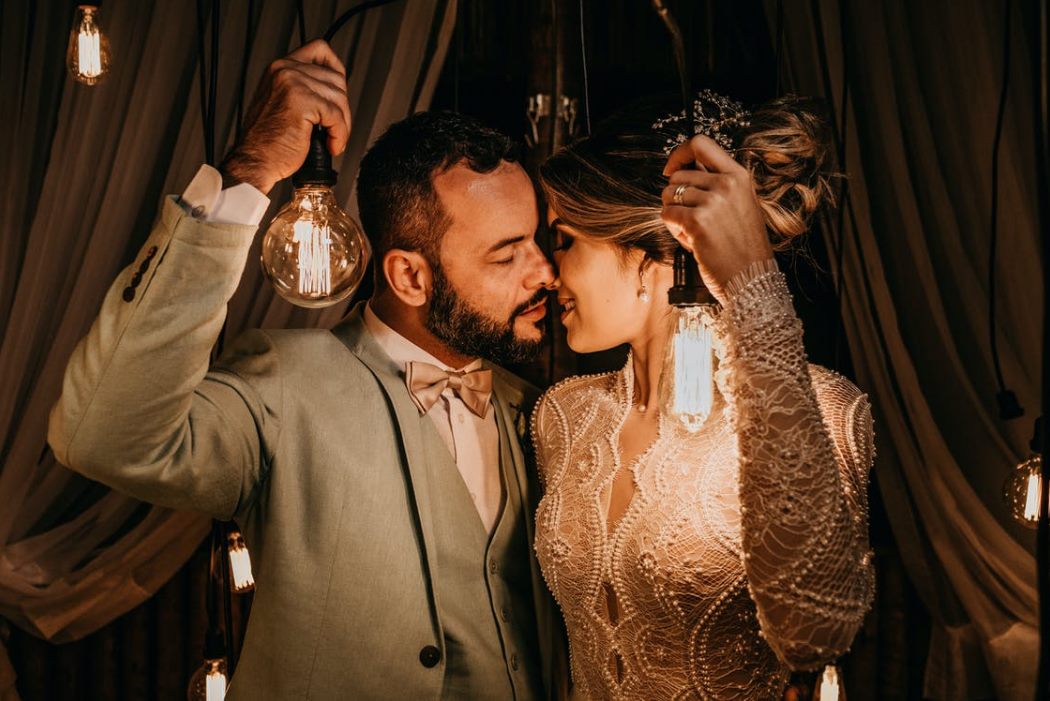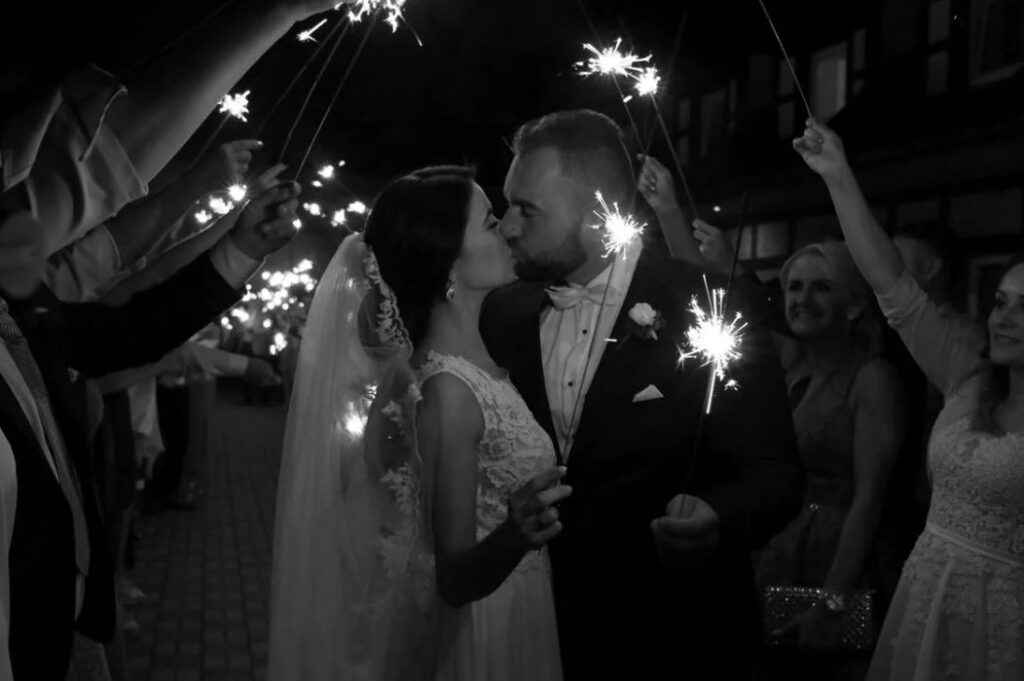Lighting is essential for creating a wedding reception atmosphere, transforming any space into a beautiful and memorable venue.
From soft, romantic uplighting to dynamic dance floor lights, each type of lighting contributes to the overall ambience and enhances the decor, making everything look picture-perfect.
Key elements include ambient lighting for a warm glow, accent lights to highlight focal points like the cake or floral arrangements, and task lighting to illuminate practical areas such as tables or pathways.
Understanding these basics can help couples create a balanced, visually appealing environment that complements their theme. Read this blog to know more!
Let's Get Straight To The Point
Wedding reception lighting is essential for setting the mood and enhancing the venue's atmosphere. Basic lighting types include ambient lighting for warmth, accent lighting to highlight focal points and task lighting for functional areas. Proper colour matching, light quality, and light modifiers can improve photography by reducing harsh contrasts and shadows.
Tips for capturing great photos include setting camera parameters for low-light conditions, using flash-bouncing techniques, and positioning to minimise shadows. DJ lights should be managed to avoid interference during key moments, and creative foreground lights like string lights can add artistic flair.
Lighting choices should align with wedding themes, from classic chandeliers and twinkle lights for outdoor magic to modern LED accents and projection effects. Consulting a lighting designer can ensure every area is beautifully lit, creating a memorable ambience that complements the wedding's style and enhances photo quality.
1. Matching Light Colour And Quality

Lighting quality and colour consistency are crucial for capturing beautiful photos without harsh contrasts or colour mismatches.
- Balance Lighting Sources: Adjust the camera's custom colour temperature to match ambient lighting, creating a harmonious look.
- Avoid Colour Clashes: Ensure your primary flash source blends well with the ambient light to prevent visual distractions.
2. Using Light Modifiers For Soft, Natural Effects
Light modifiers are essential tools that soften the camera's flash and minimise shadows, enhancing the natural look of photos.
- Diffusing Flash: Use grids or softboxes on off-camera flashes to control light direction, reducing the risk of light spilling onto unwanted areas.
- Low Power Settings: Keep the power low to maintain subtle, natural lighting across the room.
3. Setting Camera Parameters For Low Light
The right camera settings make all the difference, especially in low-light wedding receptions.
- ISO Range: Set ISO between 800 and 3200, adjusting based on available light.
- Shutter Speed and Aperture: Use a shutter speed of 1/200s to prevent blurriness, and set a wide aperture to allow more light in for clearer images.
4. Making Use Of On-Camera Flash Bouncing Techniques
Bouncing your flash-off walls and ceilings can enhance lighting quality without adding extra fixtures.
- Bounce-Off Ceilings or Walls: Use light-coloured walls or ceilings to diffuse the flash, achieving soft lighting effects without harsh shadows.
- Adapt to Venue Decor: Some venues may have darker walls or ceilings, requiring creativity to bounce light effectively.
5. Managing DJ Lights For Key Moments
DJ lights can add energy but may interfere with your shots, particularly during special moments like the first dance.
- Coordinate with the DJ: Discuss lighting adjustments for key moments, like first dances and grand entrances.
- Minimise Distractions: Ensure the DJ's lights do not overwhelm the scene, keeping focus on the subjects.
6. Positioning Relative To Subjects For Optimal Angles
Positioning yourself well ensures you capture each moment's essence without interference from light sources or obstacles.
- Experiment with Angles: Test various positions to find the optimal light setup.
- Avoid Shadows on Subjects: Adjust positioning to minimise shadows, especially during speeches and toasts.
7. Using Foreground Lights For Creative Shots
Foreground lighting can add unique, artistic touches to wedding photos.
- Adding Bokeh with String Lights: Incorporate inexpensive string lights to create a beautiful bokeh effect that draws attention to subjects.
- Experiment with Objects: Look for objects to shoot through for added texture and depth in your photos.
8. Consulting With A Professional Lighting Designer
Bringing a lighting designer on board can elevate your event, ensuring each venue part is optimally illuminated.
- Find a Specialist: Speak with your wedding planner or venue coordinator for recommendations.
- Expert Advice: Professionals offer valuable guidance and before-and-after photos that help you visualise different lighting setups.
Choosing Lighting To Suit Wedding Style And Venue

Different wedding styles demand unique lighting solutions. Here's a breakdown of lighting tips for various wedding themes:
Classic Weddings
- Elegant Fixtures: Use crystal chandeliers or silver candelabras to create a luxurious atmosphere.
- Accent Lighting: Add subtle highlights, such as spotlights on a dessert table or a gobo monogram on the dance floor.
- Outdoor Magic: Twinkle lights work beautifully under the stars, creating a whimsical finish to the evening.
Rustic Weddings
- Market Lights and Chandeliers: Globe-shaped string lights give outdoor receptions a warm, inviting feel.
- Creative Chandelier Options: Consider unconventional chandeliers made from Edison bulbs or mason jars for a rustic charm.
- Path Lighting: Luminaries along aisles add a soft, romantic glow to outdoor settings.
Romantic Weddings
- Twinkling Lights and Lanterns: Hang fairy lights or use lanterns to create enchanting pathways and backdrops.
- Chandeliers and Pink Hues: Chandeliers and pink lighting washes add warmth and intimacy to the atmosphere.
- Lantern Release: Encourage guests to send floating lanterns into the night sky for a magical end to the evening.
Modern Weddings
- Colour Wash Lighting: Use coloured lighting to create a festive atmosphere, particularly in lofts or galleries.
- LED Floral Arrangements: Incorporate LEDs within floral centrepieces for a contemporary touch.
- Projection Effects: Add gobo patterns on venue walls or project cityscapes on the dance floor for a chic, urban vibe.
Edgy Weddings
- Industrial Lighting: Uplighting adds a dramatic edge to architectural features in historic or repurposed venues.
- Marquee Lights: String vertical market lights or customised marquee signs for added ambience.
- Edison Bulbs and Glow Sticks: Use Edison bulbs for a vintage feel, and hand out glow sticks for a late-night dance floor vibe.
Conclusion
A wedding's lighting sets the tone and defines the event's mood. By carefully planning your lighting setup, you can enhance your photography, capturing the joy and beauty of the day. Key tips include:
- Adjusting Camera Settings to suit low-light environments.
- Light modifiers are used to create soft, natural effects.
- Working with a lighting designer to achieve optimal venue illumination.
- Selecting Lighting Based on Style to match your wedding's theme.
With careful planning and collaboration, wedding lighting can be a powerful tool for creating memories that will last a lifetime.
FAQs About Wedding Venue
These include chandeliers, candles, mason jar lamps, and lanterns. Underlighting and Uplighting: While underlighting will illuminate tables or other items from below, uplighting shines light upwards-usually onto a wall.
Your basic bistro lights generally allow you to connect up to 5 strings, giving you about 60 feet of lights to work with. First, identify the most accessible locations to hang your lights.
Off-camera lighting is the most preferred lighting setup in wedding photography today. Why? Because it allows us to give directional light and controls the light's intensity, harshness, and softness by being a movable source of light.Off-camera lighting is the most preferred lighting setup in wedding photography today. Why? Because it allows us to give directional light and controls the light's intensity, harshness, and softness by being a movable source of light.
You probably don't need uplighting. But if you're having a party, you may want to look into how lighting can drastically affect your event space. Uplighting is one of the more popular wedding lighting options, and for a good reason. The proper placement of uplighting can do wonders for your space.
Market Lights, also known as Bistro Lights or Ping Pong Lights, are string lights that provide lighting for outdoor or indoor events, such as Weddings, Corporate Events, or Parties. Our Market Lights create a warm romantic ambience and give any event or occasion an intimate feel.

